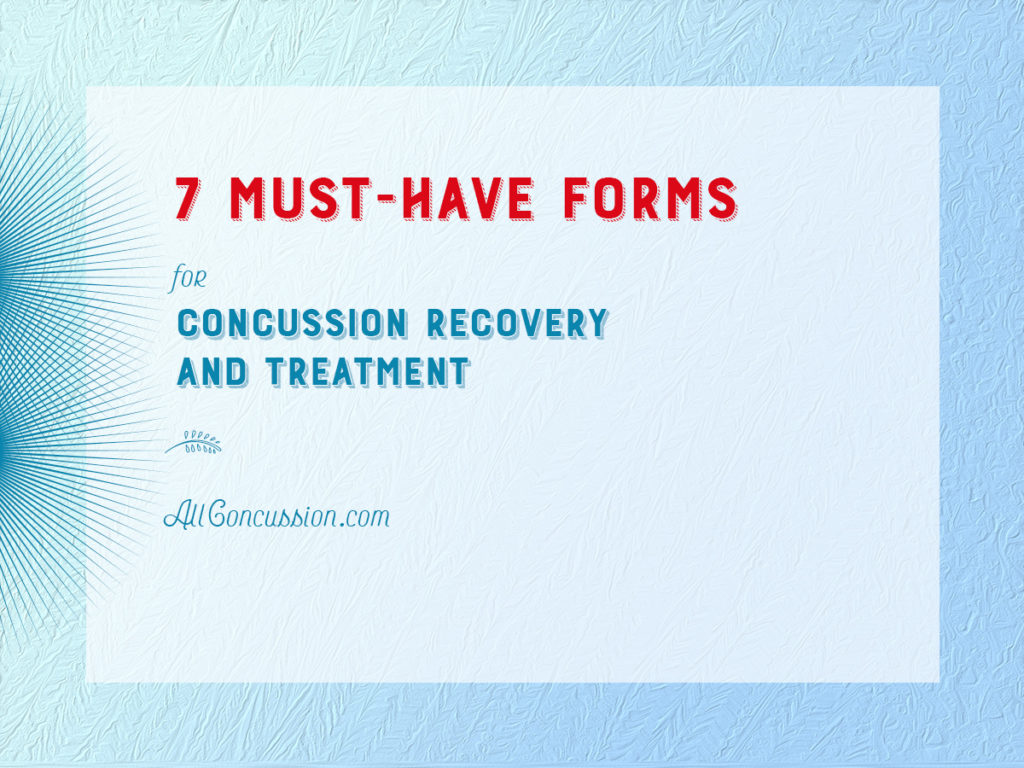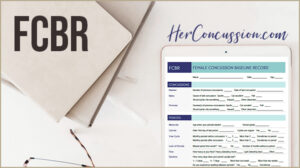
When one sustains a concussion, it can be daunting determining what to do or expect during interactions with the medical community. With that in mind, I’m sharing information about some forms related to concussion treatment and management. During my recovery, I wish I had known about all of them from the start. Some were used by physicians and others during the course of my recovery. I came across some while researching concussion and post-concussion syndrome. Others I learned of during my advocacy work. Finally, two I developed myself to address female concussions. The topics covered in those forms for females are not yet being discussed much, but there is a need for them. The forms are newly released as of the publish date of this post.
Why are these must-have forms? Because most in this list are widely used by multiple entities for varied reasons. Because of that, you should be aware of them, as should medical folks, coaches, and anyone involved with concussion. Perhaps that isn’t the case. The more knowledge you have regarding concussion, the better.
I’ve grouped the forms into general usage categories. Whether you’re a patient, caregiver, coach, medical professional, or anyone working or dealing with concussion, you should be aware of these. If you haven’t already come across these forms then take a look at them. If your health care provider isn’t aware of the forms or hasn’t heard of them, it might be something you could share.
Usage
The forms described in this post are used in varied ways. Here are a few examples.
- Concussion treatment
- Mobile apps
- Sideline assessments
- Research
Sports
I think that the form most commonly used with regard to sports is the SCAT5.
Sport Concussion Assessment Tool (SCAT5) and Child SCAT5
The SCAT5 is widely used by varied parties and areas of interest. It is the latest iteration of this form, which uses a revision number with each new version. The first form (SCAT) was developed in 2005. The second version (SCAT2) was developed in 2009. The third versions (SCAT3 and first iteration of the child form: Child SCAT3) replaced the SCAT2 as of the 2012 Zurich conference. The new versions (SCAT5 and Child SCAT5) were developed as a result of the 2016 Berlin conference. If a person or mobile application is using the SCAT2 or SCAT3, know that the form or app is out of date.
The form includes these items and more:
- BESS test results
- Symptom rating section that bears some similarity to the Rivermead Questionnaire.
- Directions for use in sideline assessments
- Section for a Glasgow Coma Scale (GCS) rating*
* Inclusion of the GCS is surprising to me, as I’ve continually heard that use of the GCS has diminished in the past few years. However, as of the publishing date of this post, I can find no authoritative links to share indicating that is the case.
I’d like to note the importance of these international consensus conferences. Decisions made at the conference (held only at four-year intervals) affect concussion treatment world-wide. The SCAT5 form (and all iterations) is one example. Development of return to play (RTP) guidelines at the 2012 conference is another. Much attention, discussion, and possible controversy occurs with each conference. One controversial issue from the Zurich 2012 conference was that a decision was made to essentially ignore gender differences. For the Berlin conference, the organizers decided to ban live-tweeting of the conference, which they decided essentially the day of the conference. This last-minute decision was a highly controversial move and generated much backlash online. People were prepared to follow along and participate and there was no indication provided beforehand that there would be a ban. The ban effectively blocked the public from providing any input via Twitter or other social media while the conference was underway. When you review the guidelines or reports, keep that in mind. The public had no input. However, the conference attendees are a veritable who’s-who for concussion medical experts, so the guidelines carry much weight and are used and referenced extensively. That’s why omissions are so controversial. Guidelines from the Berlin 2016 conference are published in the British Journal of Sports Medicine. [1] You can also find guidelines from the earlier conferences in the same publication.
Developers: Forms developed by concussion experts in attendance at the Fifth International Consensus Conference on Concussion in Berlin, October 2016
Created: 2017 (latest version)
Source files location: British Journal of Sports Medicine
Used by: medical personnel, sideline personnel, mobile apps
SCAT5
- Replaces the SCAT (2005), SCAT2 (2009), and SCAT3 (2012)
- For ages 13 and above
- Link: SCAT5
Child SCAT5
- Form initially developed following the 2012 Zurich conference (Child SCAT3) and revised in the 2016 Berlin conference (Child SCAT5)
- For ages 5-12
- Link: Child SCAT5
Update 4/30/20: A conference was originally planned to be held in Paris this coming October. Updated versions of this form usually result from these conferences. Per their website, the conference has been postponed to 2021 due to COVID-19.
Update 3/2/21: The conference has been rescheduled. The date is October 28-30, 2021. Conference information is on the website: 6th International Consensus Conference on Concussion in Sport. (Note 6/16/22: the conference was delayed one additional year.)
Update: 6/16/22: The upcoming conference is scheduled for October 28-30, 2022. It will be held in Amsterdam. Conference information is on the website: 6th International Consensus Conference on Concussion in Sport.
Treatment
There are two main forms I’ve come across: ACE and BESS.
Acute Concussion Evaluation (ACE)
This form includes symptom lists and treatment directions. There are also at least four different versions created for varied audiences. The forms are available on the CDC website. The developers are well-known leaders for concussion research and treatment.
Developers: Gerard Gioia, PhD and Micky Collins, PhD
Source files location: HEADS UP section of CDC website in Tools for Health Care Providers**
Used by: medical personnel, adult patients, student patients
Links: These are in the HEADS UP to Health Care Providers section.
- CDC HEADS UP Tools for Providers: Two ACE forms. One is for emergency physicians and the other is for clinicians.
- CDC HEADS UP Materials for Your Patients: Two ACE Care Plan forms. One is for return to work (RTW). The other is for return to learn (RTL).
** These may not be the original source, but the CDC provides current information for all audiences, so I think it’s a good source for the forms.
Balance Error Scoring System (BESS)
BESS is a balance test. The BESS form is the written record of the test results. The test is typically conducted by medical personnel. It might also be performed on the sideline of a sporting event. The test is subjective. The tester observes a person completing various physical balance tasks and counts errors. Then the tester tabluates and records the errors on the form. I haven’t seen an official designed BESS form or found a source location of the form. In my recovery, a physical therapist used it for my vestibular PT along with use of a forceplate to gather data used to direct treatment.
Update 6/16/22: I think the test is outdated and should be obsolete. A forceplate should be used instead when possible, as it provides actual data instead of subjective assessments. Because the BESS is subjective on the part of the tester, the BESS is not as accurate as a test where the patient stands on a forceplate.
Used by: physicians, physical therapists, athletic trainers, sporting event sideline personnel
Source file location: Search online to find one. You might want to look for several.
Description: BESS findings are also included as part of the SCAT5.
Treatment and Research
Rivermead Post Concussion Symptom Questionnaire
From what I can determine, I think that this form was one of the first, if not the first. It was released in 1995. [3] The questionnaire is a list of symptoms. Patients rate the severity of each symptom on a scale from 0-4. To find a questionnaire, search in your favored search engine for ‘Rivermead Post Concussion Symptom Questionnaire” (without quotes). There are many PDF files of the questionnaire that display in search results, and perhaps some variations of the questions. I’m not sure how much this form is currently used by physicians, for example. However, given its history and use in research, you should be aware of its existence.
Used by: medical personnel, researchers
Use in Research
The questionnaire has long been used in research for a wide variety of topics related to concussion. It’s still used for current research. If you search in PubMed for “Rivermead Questionnaire,” “Rivermead concussion” or similar searches (without quotes) you’ll see quite a list of studies from 1995 through today. Here is a sampling:
- Heart Rate Variability of Athletes Across Concussion Recovery Milestones: A Preliminary Study (July 2016)
- The value of neurocognitive testing for acute outcomes after mild traumatic brain injury (July 2016)
- Clinical and imaging assessment of acute combat mild traumatic brain injury in Afghanistan (July 2015)
- Playing ice hockey and basketball increases serum levels of S-100B in elite players: a pilot study (September 2003)
- The Rivermead head injury follow up questionnaire: a study of a new rating scale and other measures to evaluate outcome after head injury (May 1996; an early use)
Females
There are several new forms related to female concussions. I developed these forms to fill a gap. Female concussions have been overlooked in research and focus. This is changing. However, there is little if any discussion about female-specific items in baseline tests. Nor have there been any forms that address menstrual cycle dysfunction after concussion. To fill this void, I created two forms that address these needs. They’re described below and you can find them through the links for each form.
You can download, use, and share both forms as is. To share online, please link to the files (not upload to a site) and provide attribution when doing so.
Developer: Julie Norris
Updated: March 2018
Created: July 2016
Used by: concussees, medical personnel
Source files location: HerConcussion.com
Links: You can find both forms on the Downloads page: Downloads -Menstrual Cycles and Concussion Survey and Forms. Update 4/30/20: These are temporarily unavailable, but will be restored soon. Update 6/16/22: They are currently available, but may be unavailable periodically.
Description: see below for each form
Female Concussion Baseline Record (FCBR)
The FCBR contains female-specific questions related to concussion. Typical baseline testing reviews cognitive functioning and balance. The FCBR is the only item of which I’m aware that addresses menstrual cycles and symptoms more commonly associated with females. Because menstrual cycle issues can (and do) occur following a concussion, I think it’s important to record a person’s cycle characteristics as a baseline. The form includes the following items.
- Concussion history
- Menstrual cycle information and history
- Physical activity levels and type
- Symptoms related to concussion and menstrual cycles
Menstrual Cycle After Concussion (MCAC)
The MCAC tracks menstrual cycle issues which occur following a concussion. Form content is based on my experience working with this topic, my survey questions, and responses from those that completed the survey. It addresses changes following a concussion, including the following.
- Changes in duration: shorter, longer, stopped
- Changes in flow: heavier or lighter
- Symptom severity during a period
- Menstrual cycle history
[1] McCrory P, Meeuwisse W, Dvořák J, et al Consensus statement on concussion in sport—the 5th international conference on concussion in sport held in Berlin, October 2016 Br J Sports Med 2017;51:838-847.
[3] King NS, Crawford S, Wenden FJ, et al, “The Rivermead Post Concussion Symptoms Questionnaire: a measure of symptoms commonly experienced after head injury and its reliability” J Neurol. 1995 Sep;242(9):587-92


